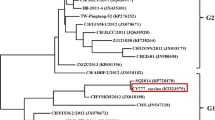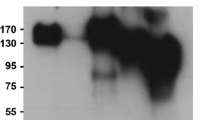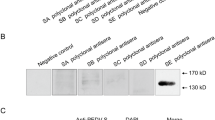Abstract
VP1, a capsid protein of swine vesicular disease virus, was cloned from the SVDV HK/70 strain and inserted into retroviral vector pBABE puro, and expressed in PK15 cells by an retroviral expression system. The ability of the VP1 protein to induce an immune response was then evaluated in guinea pigs. Western blot and ELISA results indicated that the VP1 protein can be recognized by SVDV positive serum, Furthermore, anti-SVDV specific antibodies and lymphocyte proliferation were elicited and increased by VP1 protein after vaccination. These results encourage further work towards the development of a vaccine against SVDV infection.
Similar content being viewed by others
References
Borrego B, Carra E, Garcia-Ranea J A, et al. 2002. Characterization of neutralization sites on the circulating variant of swine vesicular disease virus (SVDV): a new site is shared by SVDV and the related coxsackie B5 virus. J Gen Virol, 83: 35–44.
Brocchi E, Zhang G, Knowles N J, et al. 1997. Molecular epidemiology of recent outbreaks of swine vesicular disease: two genetically and antigenically distinct variants in Europe, 1987–1994. Epidemiol Infect, 118: 51–61.
Dekker A. 2005. Herd sensitivity in relation to test sensitivity in swine vesicular disease serological tests. Rev sci tech Off int Epiz, 24(3): 1077–1083.
Graves J H. 1986. Swine vesicular disease. In: Diseases of Swine (Leman A D, Straw B, Glock R D, et al Eds.), 6th ed., Ames: Iowa State University Press, p384–352.
Hu W S, Pathak V K. 2000. Design of retroviral vector and helper cells for gene therapy. Pharmacol Rev, 52: 493–511.
Inoue T, Suzuli T, Sekiguchi K. 1989. The complete nucleotide sequence of swine vesicular disease virus. J Gen Virol, 70: 919–934.
Jimenez-Clavero M A, Douglas A, Lavery T, et al. 2000. Immune recognition of swine vesicular disease virus structural proteins: novel antigenic regions that are not exposed in the capsid. Virol, 270: 76–83.
Kanno T, Inoue T, Wang Y, et al. 1995. Identification of the location of antigenic sites of swine vesicular disease virus with neutralization-resistant mutants. J Gen Virol, 76: 3099–3106.
Kanno T, Mackay D, Inoue T, et al. 1999. Mapping the genetic determinants of pathogenicity and plaque phenotype in swine vesicular disease virus. J Virol, 73: 2710–2716.
Kozak M. 1986. Point mutations define a sequence flanking the AUG initiator codon that modulates translation by eukaryotic ribosomes. Cell, 44: 283–292.
Kwon Y J, Hung G, Anderson W F, et al. 2003. Determination of infectious retrovirus concentration from colony-forming assay with quantitative analysis. J Virol, 77: 5712–5720.
Nardelli L, Lodetti E, Gualandi G L, et al. 1968. A foot and mouth disease syndrome in pigs caused by an enterovirus. Nature, 219: 1275–1276.
Nijhar S K, Mackay D K., Brocchi E, et al. 1999. Identification of neutralizing epitopes on a European strain of swine vesicular disease virus. J Gen Virol, 80: 277–282.
Rebel J M, Leendertse C H, Dekker A, et al. 2000. Construction of a full-length infectious cDNA clone of swine vesicular disease virus strain NET/1/92 and analysis of new antigenic variants derived from it. J Gen Virol, 81: 2763–2769.
Tsuda T, Tokui T, Onodera T. 1987. Induction of neutralizing antibodies by structural proteins VP1 and VP2 of swine vesicular disease virus. Jap J Vet Sci, 49: 129–132.
Sun S Q, Liu X T, Guo H C, et al. 2007. Protective immune responses in guinea pigs and swine induced by a suicidal DNA vaccine of the capsid gene of swine vesicular disease virus. J Gen Virol, 88(Pt 3): 842–848.
Vigna E, Naldini L. 2000. Lentiviral vectors: excellent tools for experimental gene transfer and promising candidates for gene therapy. J Gen Med, 2: 308–316.
Zheng H X, Liu X T, Shang Y J, et al. 2006. Infective viruses produced from full-length complemen-tary DNA of swine vesicular disease viruses HK/70 strain. Chin Sci Bull, 51: 2072–2078.
Ye G S, Liu X T, Zhang Y M, et al. 2005. Determination and Analysis of Complete Nucleotide Sequence of Swine Vesicular Disease Virus. Chin J Virol, 21(1): 69–71.
Author information
Authors and Affiliations
Corresponding author
Rights and permissions
About this article
Cite this article
Tian, H., Wu, Jy., Shang, Yj. et al. Expression and immunological analysis of capsid protein precursor of swine vesicular disease virus HK/70. Virol. Sin. 25, 206–212 (2010). https://doi.org/10.1007/s12250-010-3100-x
Received:
Accepted:
Published:
Issue Date:
DOI: https://doi.org/10.1007/s12250-010-3100-x




